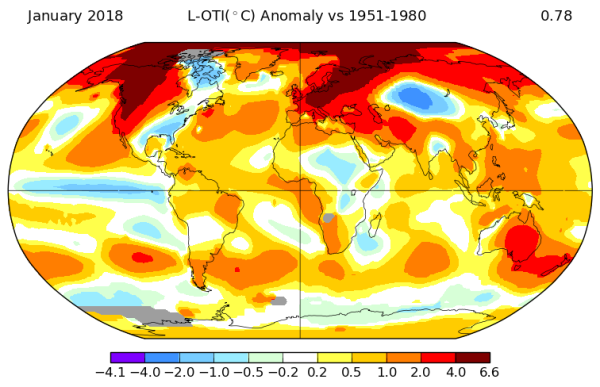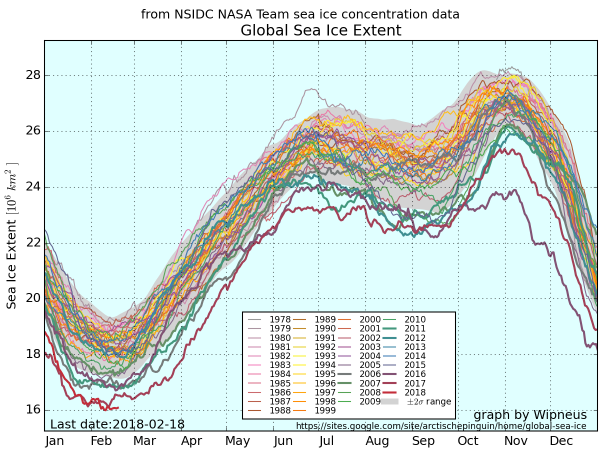Despite Stronger La Nina, January of 2018 was the Fifth Hottest in the 138 Year Climate Record
20
February, 2018
Major
signals of on an ongoing and inexorable global warming trend
continued to be apparent during January of 2018, according
to NASA records.
The
first month of this year saw global temperatures in the range of 0.78
degrees Celsius above NASA’s 20th Century baseline — or
about 1 C warmer than 1880s averages when NASA record-keeping began.
Despite
the influence of La Nina — which
during 2018 is stronger than a similar 2017 Pacific Ocean cooling
event —
January was the 5th hottest such month in all of the 138 year global
climate record. According to NASA, all of the top five hottest
Januaries ever recorded have occurred since 2007, with
four of those five occurring during the last five years.
(Arctic
warming is the primary feature of the fifth hottest January in NASA’s
138 year climate record. Image source: NASA.)
Warm
temperature departures for the month were most extreme over the
Arctic, over western North America, and through North and Western
Europe. This outlier warmth contributed to record low sea ice extent
measures in the Arctic and helped to rapidly expand drought
conditions across the U.S. In the Southern Hemisphere, Antarctica —
recently seeing a
series of glacial calving events in the west which hint at a
quickening pulse of ice entering the world’s rising oceans —
saw an abnormally warm austral summer month. Meanwhile, Australia
experienced its own third hottest January even as
concerns over renewed mass coral bleaching across the Great Barrier
Reef were again on the rise.
The intervention that's needed to protect the #GreatBarrierReef is stopping new coal mines and subsidies for fossil fuels. twitter.com/krnanthony/sta…
During
La Nina, movement of warm air and water toward the polar region is
enhanced. To this point, global sea ice extent measures are again in
record low ranges even after receiving a serious hammering during the
winter of 2017. In January, record to near record polar warmth helped
to drive a rapid fall in global sea ice extent to today’s record
low values in the range of 16 million square kilometers.
Record
low sea ice coverage is a climate change amplifier in that it
uncovers dark ocean surfaces that capture more of the sun’s rays
than white, reflective ice. In addition, open ocean ventilates more
heat into the polar atmosphere. Heat that would typically be
sequestered beneath the ice. This warming amplification (polar
amplification) can also have an impact on the polar circulation of
the Jet Stream — causing
it to meander more which results in increasing instances of extreme
weather (hot, cold, wet, dry, stormy) in the middle latitudes.
(Global
sea ice extent is again in record low ranges. This is a primary
signal of a warming polar environment — which can have far-ranging
harmful impacts. Image source: Global
Sea Ice and NSIDC.)
Over
the coming months, we should expect some continued stress to both
Arctic and Antarctic sea ice — with the caveat being that cloudier
late springs and early summers have tended to retard warm season ice
loss during recent years in the Northern Hemisphere. That said,
continued movement into record low ranges for the Arctic hint that
rapid advance of melt during winter may eventually translate to
summer.
The
primary driver of these serious changes to the global environment is
continued fossil fuel burning. And with atmospheric CO2 likely to hit
between 411 and 412 parts per million this year (with CO2e ranging
toward 493 ppm adding in all greenhouse gasses) the amount of warming
already being locked in is starting to look quite dangerous in a
number respects. That said, damage can still be greatly limited if
the world works to rapidly transition toward renewable energy and
keeps harmful fuels where they belong — in the ground.
2018 Starts With “Record Lows In Arctic Sea Ice Extent”
“Sea
ice fell to its lowest level since human civilization began more than
12,000 years ago.”
Arctic temperatures are soaring, and scientists are freaking out

The
planet keeps heating up and melting ice at a "frightening"
pace.






No comments:
Post a Comment
Note: only a member of this blog may post a comment.